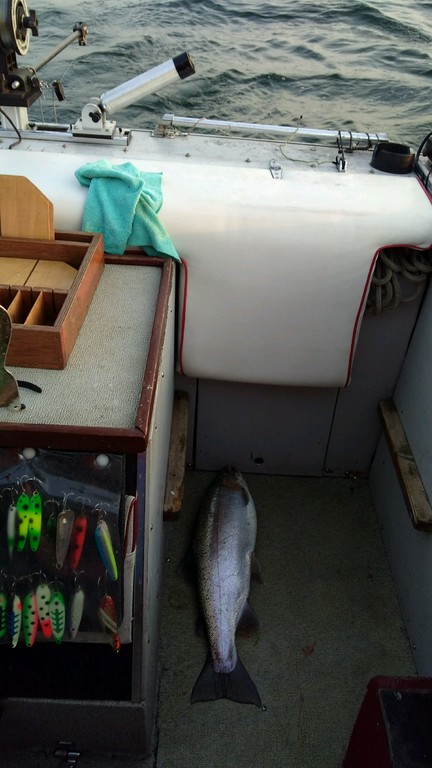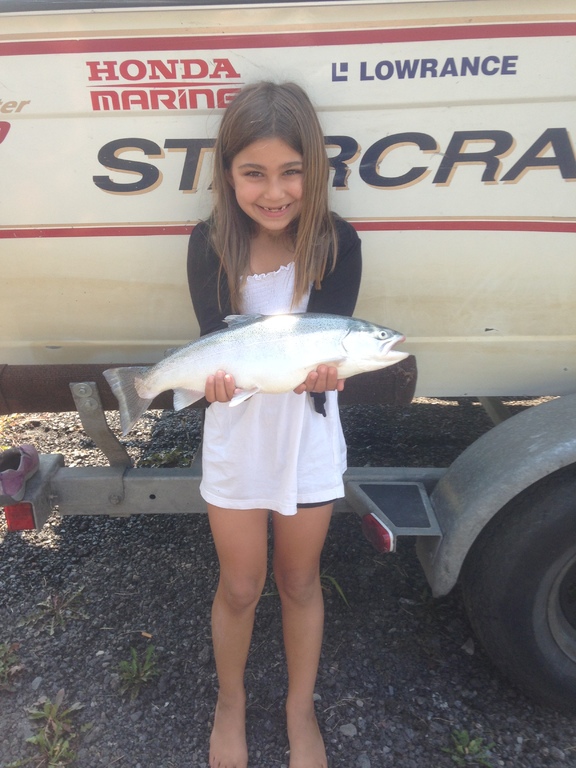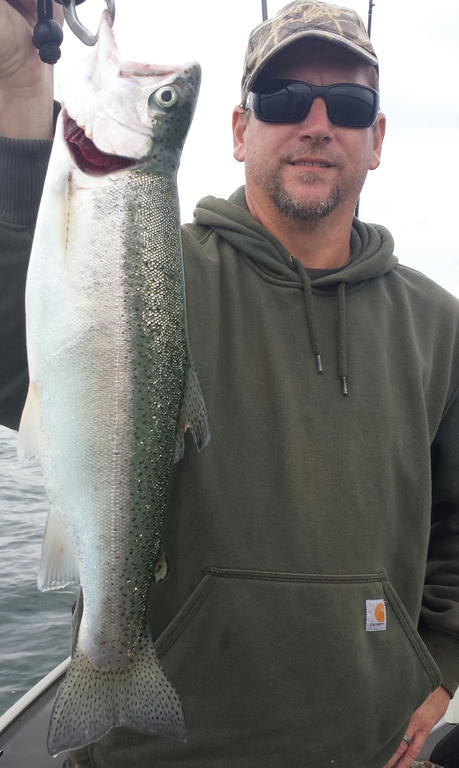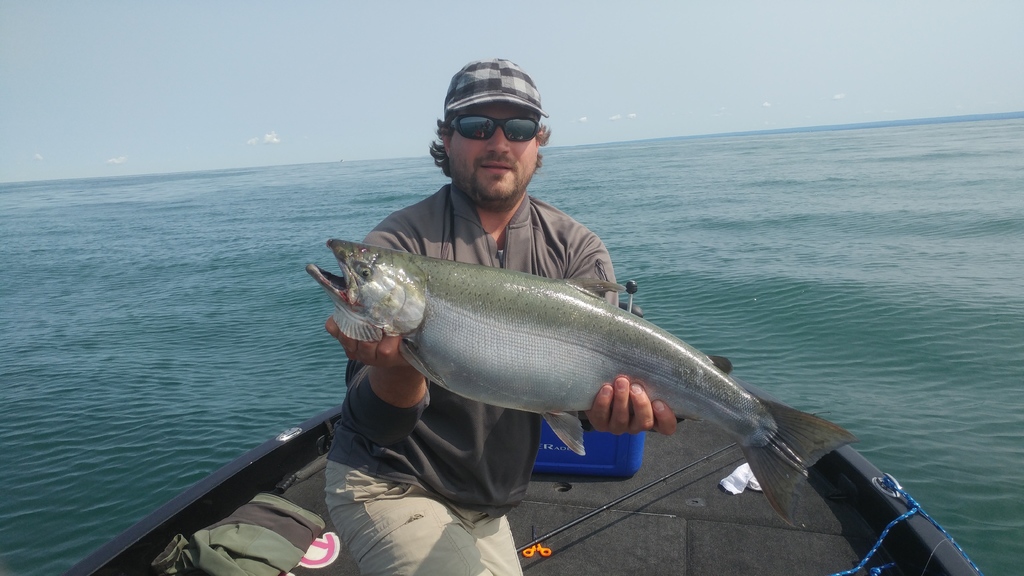-
Posts
13,865 -
Joined
-
Last visited
Everything posted by Sk8man
-
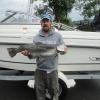
questions for the experts
Sk8man replied to Craigaf's topic in Questions About Trout & Salmon Trolling?
Kind of a "loaded" question ("experts") just a serious sport fisherman 30 lb stranded ss wire TO the dipsey. I use 40 or 50 lb test mono now to the attractor from the dipsey and 40-50 lb test from the attractor to the fly. If using just a spoon behind the dipsey - 30 lb Big Game mono and solid ring swivel snap. I start with about 25 ft. lead on the riggers of 30 lb Sea Flee and experiment from there. Shorter tighter lead the deeper I set the riggers usually and close to the weight around this time of the season for better hookups. I use 30 lb test Sea Flee line as mainline (to repel fleas) and 20 lb Seguar fluoro leader about 20 ft long solid ring swivel to spoon. If I run hardware off riggers (e.g. attractors) I remove the fluoro leader and go with straight 30 lb Sea Flee. -

Cayuga B & B Fall Trout and Bass fishing derby on Cayuga Lake
Sk8man replied to Fishbowl836's topic in Finger Lakes Discussion
-
-

Cayuga B & B Fall Trout and Bass fishing derby on Cayuga Lake
Sk8man replied to Fishbowl836's topic in Finger Lakes Discussion
-
I run the 124 mm Deeper Divers too and often run two per side on my 18 1/2 ft boat. I set the closest in to 1 (to stay away from my riggers) and the outside ones to 2 1/2 or 3 and they seem to run fine in terms of outward and separation between them. I seldom run smaller divers than them any longer because of the increased depth range of them.Trolling speed is always a consideration as are severe turns
-
Lilly is right. The seven strand stinless steel wire can act like a hack saw on the tip and or line guides unless the friction path is redirected by either a roller tip or a twilli. The twilli tip is the least expensive and perhaps the easiest solution for most folks as good quality roller tips can be expensive (some wellover $100 in the salt water environment) and they vary greatly in diameter so you have to pretty much know the actual diameter of the rod tip shaft and how it corresponds to the diameter number of the roller tips for a good fit. The twillis come with several adaptors in the package and the total cost is less than $10. The cheaper roller tips may have aluminum side plates which when the rod is at an inappropriate angle (say from wave action when in the rod holder) the 7 strand wire may see saw into or through the side plate. All steel roller tips with steel side plates are necessary when using the 30 lb 7 strand wire.
-
-

Pultneyville
Sk8man replied to john1947's topic in New York Fishing Reports - Lake Ontario (South Shore)
-
-
I fished on this boat just this morning and it is set up perfectly for everything from perch and panfish to salmon. It is a true fishing machine with a lot of room, comfortable seats, canvas protection from the wind (was windy out here today but you'd never know it inside the canvas). Great storage and the motors ran flawlessly including the Ipilot with remote. In short....Iwas jealous great boat!
-
Send them to Andy Copenhaver at Tuna's Reel Troubles and have him go over them and put in carbon fiber drags. It will help but won't make them into high end reel drags either. They are very competent folks there and great at customer servicing, fair with their pricing, and quick on the turn around.
-
The quality of the antennae itself is a large factor in transmission and reception....not all them are equal to the job.
-

What Fillet Knife Do You Use On Large Salmon/Trout?
Sk8man replied to Todd in NY's topic in Open Lake Discussion
I also avoid the fatty areas near the spine and belly because that is where most of the potential contaminants are stored and I remove the greyish lateral line material as well during the filleting as it is an area where the strong taste comes from. Bleeding the fish soon after catching them also helps reduce the strength of the taste. -
Mike gave you the "play by play" of it
-
One of the problems regarding the cormorants in numbers is water pollution from their feces. It has happened to freshwater ponds on Cape Cod big time. Combined with large numbers of geese wintering over etc. you have to wonder what the total effect may be on these lakes especially the smaller ones that already are plagued by blooms of blue-green algae.
-
-

What Fillet Knife Do You Use On Large Salmon/Trout?
Sk8man replied to Todd in NY's topic in Open Lake Discussion
I use both the large Victorinox and the Dexter-Russell for salmon (when or if I keep them) and a 7 inch Rapala for smaller fish and I frequently sharpen the Rapala. The electric is reserved for perch and walleyes. -
-

Finally!
Sk8man replied to dvdegeorge's topic in New York Fishing Reports - Lake Ontario (South Shore)
Nice going Dan -
I never let my boards release but I have the TX 44's and the Walleye boards.. My releases are tightened as far as I can tension wise (without unduly stressing the plastic so they break) and I insert the braid as far back in the grip as I can and sometimes I even wrap the braid a couple times around the release if run in rough water. When bringing in the fish I try to keep the pressure constant on the fish and take the board off the line when it reaches the boat. If the board dives I point the rod directly at it downward without giving slack and reel and it comes in.
-


